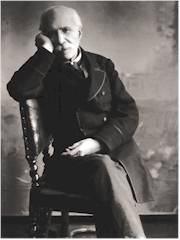Manuel Patricio Garcia, son of the tenor Manuel del
Pópulo Vicente García, is renowned as one of history's
great teachers of singing. His scientific study of the larynx
through the use of a laryngoscope led to his formerly being
considered the inventor of the instrument, but that claim is
now disputed.
He began musical studies with his father in Naples in 1814. He
had a few lessons with his father's teacher there, Giovanni
Ansani (1744-1826), and also studied theory with the composer
Niccolò Zingarelli (1752-1837). In 1820 he studied harmony
with François-Joseph Fétis in Paris.
In 1825 he traveled with his family to New York and sang
Figaro in the opening-night performance of Il barbiere di Siviglia
on 29 November 1825. After briefly travelling to Mexico with
his father he returned to Paris in 1828 where he made his
debut as Figaro at the Opéra Italien (with his sister, Maria Malibran, in the role
of Rosina). The poor critical reception of his performance
(Fétis, in the Revue
Musicale, commented that "he didn't know which foot
to stand on") led him to abandon a professional career on
stage.
When his father returned to Paris from Mexico in 1829, Manuel
Patricio assisted in his studio and began teaching students of
his own. He also continued to sing in performances with his
father's students. A brief stint in the military in 1830, with
subsequent work in a military hospital, led to his scientific
interest in vocal anatomy. After his father died in 1832,
Garcia came into his own as maestro
di canto and developed, through experience and
scientific observation, a groundbreaking method of vocal
pedagogy which was presented in his Traité complet de l'Art du Chant, published
in Paris in 1840.
In September of 1854 he made his first experiments with the
laryngoscope:
I purchased a dentist's mirror. Having heated
[it], I placed [it] against the uvula, then flashing upon it
with a hand mirror a ray of light from the sun, I saw to my
intense delight the larynx exposed... [address to the Royal
Society, May 12, 1859]
Probably the most important contribution to vocal pedagogy by
Manuel Patricio Garcia was his emphasis on the critical
importance of the workings of the glottis (coup de la glotte)—a
point of his teaching that has often been misinterpreted and
unjustly maligned.
Among his many pupils, most noteworthy were his sister, Pauline Viardot-Garcia,
the Swedish soprano, Jenny Lind, Johanna Wagner (niece of
Richard Wagner), Mathilde Marchesi, Julius Stockhausen,
Henriette Nissen, Charles Bataille, Catherine Hayes, and
Antoinette Sterling. His son by his first wife (soprano
Eugénie Mayer), Gustavo, had a successful career as a
baritone, as did the latter's son, Alberto.
—James Radomski
Works
Traité complet de l'art du
chant, Paris, 1840; English translation, enlarged,
London, 1894
"Memoire sur la voix humaine," in: Comptes-rendus des séances de l'Académie des
sciences, 12 April 1841
"Observations on the Human Voice," in: Proceedings of the Royal Society
of London 7, 1855, 399-410
Observations physiologiques
sur la voix humaine, Paris, 1861
Bibliography
Malcolm Sterling Mackinlay, "Manuel Garcia and His Friends.
The Reminiscences of a Centenarian," in: The Strand Magazine 29,
no. 171, March 1905, 257-67. Mackinlay was the son of
Antoinette Sterling and also a student of Garcia.
Malcolm Sterling Mackinlay, Garcia the Centenarian and His
Times, Edinburgh and London, 1908. Largely anecdotal,
this remains the only book on Manuel Patricio Garcia published
to date.
James Radomski, "Letters
from Manuel Patricio García to Pauline Viardot-García,"
in: Inter-American Music
Review, 17 (Summer 2007), nos. 1-2, 237-255. Contains
thirty-one letters from the 1840s to 1905 in the original
French, Spanish and English that Garcia used in communicating
with his sister. These provide tremendous insight into
Garcia's character and also into the relationship between
these two remarkable musicians.
James Radomski, "Manuel Garcia's Pedagogic Advice to Pauline
Viardot," in: VoicePrints,
November-December 2007, 4-7. Four letters from the above, offering interesting insights
into Garcia's teaching, are presented in English translation; available
online at: http: www.nyst.org/bulletin/voiceprints_07.5_Nov-Dec_07.pdf
Teresa Radomski, "Manuel
García
(1805-1906) – A Bicentenary Reflection," in:
Australian
Voice 11 (December
2005), 25-41. An excellent introduction to the principles of
Garcia's pedagogy.
[Return to Homepage]

